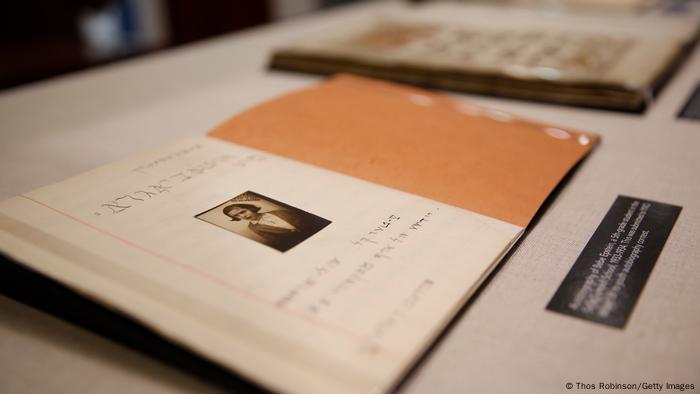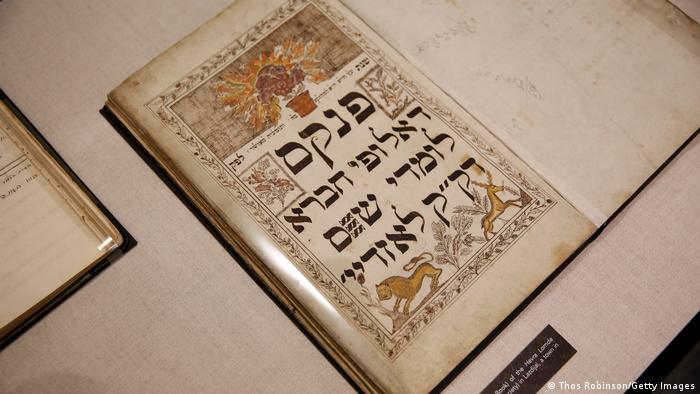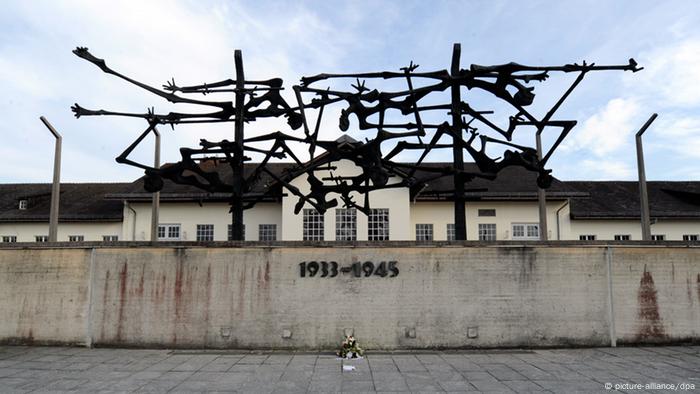In 1941, Jewish intellectuals forced to work in the Nazi-controlled Vilnius archives risked their lives to hide documents from them. These have now been digitized and can be viewed online.

'The Autobiography of Beba Epstein'
In 1925, prominent European intellectuals from the Jewish community, including Sigmund Freud and Albert Einstein, helped establish the Yiddish Scientific Institute (Yidisher Visnshaftlekher Institut, YIVO) in Berlin and Wilno, Poland (now Vilnius in Lithuania). Its task was to collect empirical evidence on modern-day Jewish life.
There was a specific reason for this.
"Everybody had been studying the Talmud since the Middle Ages. The Kabbalah of the Torah," Jonathan Brent, CEO and executive director of the New York-based YIVO Institute of Jewish Research told DW. "But nobody knew what was the actual day-to-day process whereby Jews survived, made their way in the world, cared for their children. What were their actual traditions? What were their songs? What were their relations with their neighbors and their non-Jewish neighbors?"
A project of self-discovery
The same year that YIVO was founded, Max Weinreich, the then-head of YIVO's Wilno (also known as Vilna) branch sent "zamlers" — Yiddish for 'collectors' — around the world to collect information and material from Jewish communities.
He also published advertisements asking people to send posters, letters, political statements, and books as materials for the study on modern Jewish life. YIVO CEO Jonathan Brent explained that Weinreich's call "inflamed the imagination of Jewish people."
"They were excited about this idea. It's not like discovering the faith of a Holy Roman Empire or something that happened in 1492. It was self-discovery…The idea of the YIVO Institute was that this process of self-discovery would equip people to enter into the modern world and build a modern Jewish identity," he added.
Over the next few years, YIVO evolved into "the largest collection of material in the world on East European Jewish life," according to its website.
The same year that YIVO was founded, Max Weinreich, the then-head of YIVO's Wilno (also known as Vilna) branch sent "zamlers" — Yiddish for 'collectors' — around the world to collect information and material from Jewish communities.
He also published advertisements asking people to send posters, letters, political statements, and books as materials for the study on modern Jewish life. YIVO CEO Jonathan Brent explained that Weinreich's call "inflamed the imagination of Jewish people."
"They were excited about this idea. It's not like discovering the faith of a Holy Roman Empire or something that happened in 1492. It was self-discovery…The idea of the YIVO Institute was that this process of self-discovery would equip people to enter into the modern world and build a modern Jewish identity," he added.
Over the next few years, YIVO evolved into "the largest collection of material in the world on East European Jewish life," according to its website.
Nazi takeover
YIVO's success, however, was short-lived. The Nazis had occupied Poland in 1939 and entered Vilnius in 1941. Nazi troops, under Alfred Rosenberg, an NSDAP ideologue and the Third Reich's minister for the eastern occupied territories, seized YIVO's collections. The idea was to destroy part of the material and send some of it to Frankfurt to serve as fodder for the antisemitic ideology that was being churned out by the Institute for Research on the Jewish Question (in German, Institut zur Erforschung der Judenfrage).
Because the Nazis were not well-versed with Jewish culture and local languages, they needed people to sort through YIVO's extensive collections. So, they employed around 32 forced laborers — consisting of mostly Jewish intellectuals that included Yiddish poets Shmerke Kaczerginski and Avrom Sutzkever, and former YIVO co-director Zelig Kalmanovitch — to sift through the archives.
Making away with the loot
When the Nazies occupied Vilnius, they forced the Jews into ghettos and intellectual Jewish slave laborers were roped in for the sorting project inside the YIVO building. At some point, the members of the group decided they didn't want to give the Nazis everything. Many doubts circled their minds: "They could get bombed by the allies. What if the Nazis burned everything at the end of the war?" So, the group decided to hide the documents in the ghettos, Brent explained.
"And in an unbelievable effort, they hid books and papers and all kinds of things on their bodies under their clothes, their pants and their shoes. They walked out of the YIVO building with this material and they walked into the ghetto with it. If any one of them had been detected doing this, they would have been shot on the spot immediately," the expert on Jewish studies continued.
The group succeeded in getting hundreds of thousands of pages of materials and books, and these materials were then hidden in metal canisters underground and a fair amount of it was also given to their non-Jewish friends, namely the Lithuanians and the Poles.
After the war
By 1945, much of the material that had been sent to Frankfurt by the Nazis was recovered by a US organization called the Monuments Men and sent to New York, where YIVO's Max Weinreich had fled, and was setting up a new base for the organization. In Vilnius, the documents were dug out after WWII ended in 1945.
"Sutzkever and Kaczerginski had the idea of building a new Jewish museum of Vilnius," Brent explains, adding that by the time, Vilnius had become the capital of Lithuania, which was under Soviet occupation. But soon enough, the Soviets began their own campaign against the Jews.
This time round, there were no remaining Jewish intellectuals to rescue the documents. Instead, it was the Lithuanian librarian, Antanas Ulpis, who preserved the materials in the nooks and crannies of the St.George Church and Carmelite monastery in the Lithuanian capital.
The documents were eventually discovered after the fall of the Soviet Union in 1991.
By 1945, much of the material that had been sent to Frankfurt by the Nazis was recovered by a US organization called the Monuments Men and sent to New York, where YIVO's Max Weinreich had fled, and was setting up a new base for the organization. In Vilnius, the documents were dug out after WWII ended in 1945.
"Sutzkever and Kaczerginski had the idea of building a new Jewish museum of Vilnius," Brent explains, adding that by the time, Vilnius had become the capital of Lithuania, which was under Soviet occupation. But soon enough, the Soviets began their own campaign against the Jews.
This time round, there were no remaining Jewish intellectuals to rescue the documents. Instead, it was the Lithuanian librarian, Antanas Ulpis, who preserved the materials in the nooks and crannies of the St.George Church and Carmelite monastery in the Lithuanian capital.
The documents were eventually discovered after the fall of the Soviet Union in 1991.
1.5 million online exhibits
Jonathan Brent became the CEO of the YIVO Institute in New York in 2009. When he visited Lithuania that year, the documents were being stored, as he puts it, "in dark unventilated rooms." Nobody saw or read these materials, which were steadily deteriorating.
Consequently, in 2015, Brent and his colleagues initiated the Edward Blank YIVO Vilna Online Collections project, to digitize the documents, with the additional aim of virtually reuniting YIVO's collections from Lithuania and New York. Some $7 million (€6.2 million) and seven years later, this collection is now online.
Today, YIVO owns over 40,000 rare and unique books and periodicals, and over 1.5 million documents collected from Jews in Eastern Europe.
This includes the "Autobiography of Beba Epstein," which was written in the 1933-1934 school year by Beba Epstein, then aged 11 or 12. Her book, which can be viewed on the YIVO museum's website is described as providing "a look into the life of a vibrant, young girl and an insight into the life of Jewish children in Eastern Europe before the Holocaust."
'NEVER AGAIN': MEMORIALS OF THE HOLOCAUSTDachau Concentration Camp Memorial SiteA large sculpture stands in front of Dachau. Located just outside Munich, it was the first concentration camp opened by the Nazi regime. Just a few weeks after Adolf Hitler came to power, it was used by the paramilitary SS Schutzstaffel to imprison, torture and kill political opponents of the regime. Dachau also served as a prototype and model for the other Nazi camps that followed.
Another notable example is a diary of Theodor Herzl, who convened the first Zionist Congress in Basel, Switzerland in 1897, following the publication of his book "The Jewish State" in 1896. He is one of the founders of the political form of Zionism, which was the movement to establish a Jewish homeland.
"It's the largest collection of pre-war material on Jewish life: Folklore, music, poetry, plays, political organizations, social organizations, cooking, medical records, the organization of the school systems," Brent explained.
The material aims to give its viewers an understanding of how Jewish society was organized — and not without a sprinkling of humor from the olden days. For instance, a 1927 Yiddish hiking manual offers the following advice to its young readers: "Backpacks must be hung up. It's happened before that even a rucksack can go missing and only turn up again in the mouth of a cow!"
The Edward Blank YIVO Vilna Online Collections can be accessed here.
Edited by: Brenda Haas
AUDIOS AND VIDEOS ON THE TOPIC
A catastrophe in court - The Eichmann Trial, 60 years ago



No comments:
Post a Comment